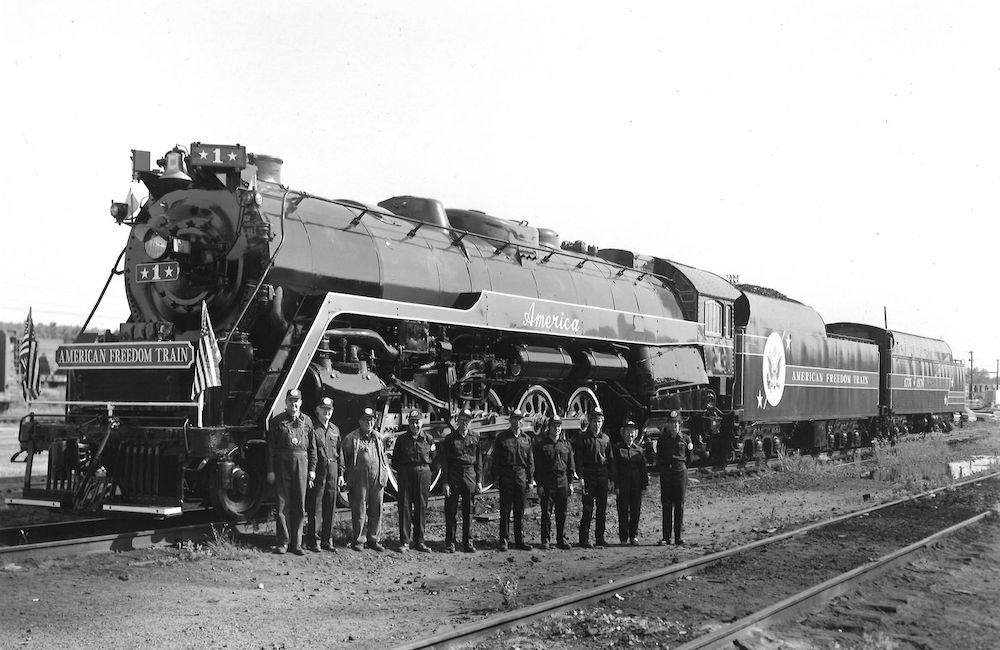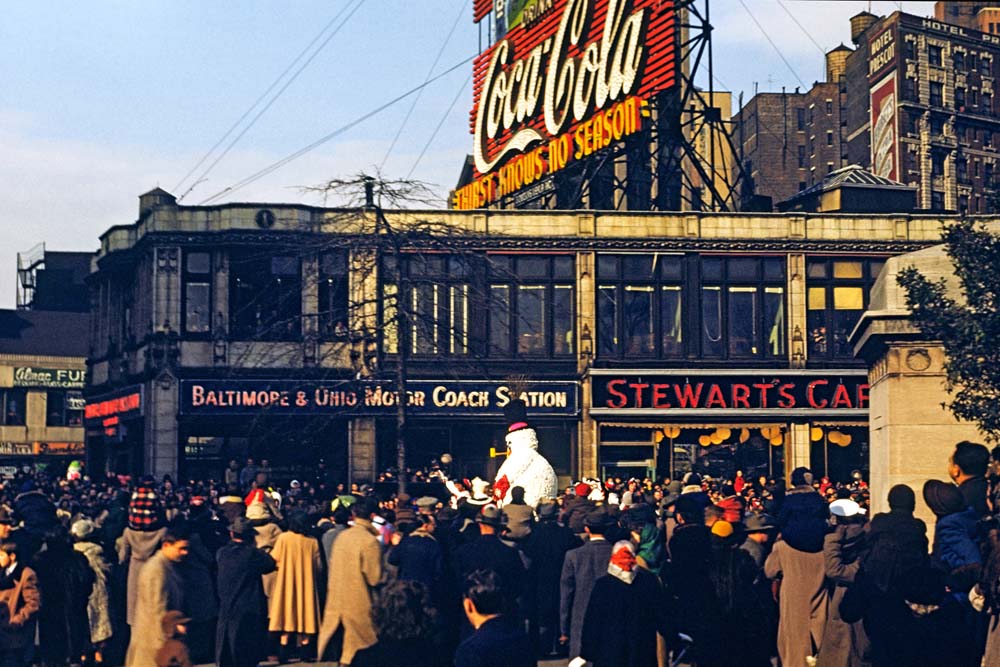
The American Freedom Train steam locomotives were stars in their own right during the U.S. Bicentennial tour. From 1975 to 1976, a total of three each took turns leading the 26-car exhibit train full of American artifacts through 48 contiguous states. What were these patriotic steam stars and where are they now?
Southern Pacific No. 4449
The American Freedom Train was always envisioned as a steam-powered exhibit train. A nationwide search for the preferred locomotive took place in the early 1970s, and eventually lead to Oaks Park in Portland, Oregon. Though a vandalized and deteriorated display piece since 1958, Southern Pacific 4-8-4 No. 4449 was chosen for its speed, strength, and style.
Built in 1941 by the Lima Locomotive Works, the “Lone Survivor” of the famous Daylight GS-class steam locomotives was removed from the park in December 1974 for restoration, led by Doyle McCormack. By April 1975, No. 4449 was ready to roll. When it initially took over the Freedom Train in Chicago later in August, the streamlined locomotive became an immediate standout among its peers. Wearing a red, white and blue livery along its skirting, No. 4449 and the train crisscrossed the country. The locomotive handled most of the tour as it traveled through more than 30 states. Its patriotic career, and the tour itself, officially concluded on December 31, 1976, in Miami.
No. 4449 returned home to Portland in 1977 and has since seen a career both productive and memorable. Many miles of excursions from its Pacific Northwest home have given the locomotive worldwide recognition. It even made multiple cross-country journeys to New Orleans in 1984 and Owosso, Michigan in 2009. No. 4449 calls the Oregon Rail Heritage Center in Portland home and serves as a centerpiece whether operating or on display. Just like its historic red, orange and black livery, the Daylight’s life after the Bicentennial tour has been glamorous. Though the same cannot be said regarding the other American Freedom Train steam locomotives.
Reading Company No. 2101
In early 1975, the American Freedom Train Foundation faced a “Daylight” dilemma. The restoration of No. 4449 in Portland was taking longer than expected, plus clearance issues in the Northeast would prohibit the large 4-8-4 from operating in parts of the region. Founder Ross Rowland and the AFT team had two options, kick off parts of the tour with diesels or pull off a miracle. The foundation went for the latter in the form of Reading Company No. 2101 found in a Baltimore scrapyard.
Originally built in 1923 as a 2-8-0 by the Baldwin Locomotive Works, later rebuilt in 1945 as a 4-8-4 by the Reading, No. 2101 was sold to scrap dealer Edward Steigel upon retirement in 1967. The locomotive was then purchased by the Foundation in 1975 for a 30-day restoration at the Riverside Roundhouse with Bill Benson leading the effort. Sister No. 2100 was also acquired as a parts engine. With the work on the re-christened AFT No. 1 completed in time, the steam-powered Freedom Train arrived in Wilmington, Delaware for its April 1, 1975, opening day. The locomotive handled the Northeast and most of the Midwest tour during the 2-year celebration. When No. 4449 relieved No. 1 for a second time in Washington, D.C., in September 1976, it marked the end of the T-1’s patriotic career.
No. 2101 returned to service in 1977, along with its original number, to head the Chessie Steam Special. This 2-year tour of excursions saw the locomotive crisscross the Chessie System in the company’s color scheme to celebrate the Baltimore & Ohio Railroad’s 150th birthday. What was a promising excursion career for No. 2101 ended in a blaze on March 7, 1979, when a fire struck the roundhouse in Silver Grove, Kentucky where the locomotive was stored. Cosmetically restored to its American Freedom Train No. 1 appearance, the retired T-1 is now on display at the Baltimore & Ohio Railroad Museum in Baltimore.
Texas & Pacific No. 610
Built in 1927, this 2-10-4 Texas-type steam locomotive was an early incarnation of the “Super Power” design by Lima. No. 610 served the Texas & Pacific Railway until retirement in 1951. The locomotive was placed into ownership under the 610 Historical Foundation in 1975 with the goal of returning it to steam for the American Freedom Train.
The outdoor restoration effort with support from the Amon Carter Foundation was completed in February 1976. Just in time for the Freedom Train to begin its journey through Texas. The plan was to have No. 610 take over for No. 4449, and tour the entire Lone Star State with the train. It wasn’t until Austin that it finally began its new, yet brief career. The locomotive pulled the exhibit train to Houston, Dallas and Fort Worth before No. 4449 took over once again. The stint barely lasted a month; however, the performance and availability of No. 610 caught the attention of the Southern Railway.
In search of bigger power, the Southern leased No. 610 for use on the railroad’s steam program. From 1977 to 1980, the locomotive hauled 20-car passenger excursion trains with ease. The Smithsonian Institution’s transportation curator Bill Withuhn, Trains Magazine and the SR even performed an analytical strength test on the locomotive. Multiple issues including hot bearings plagued both No. 610 and its excursion career. The retired 2-10-4 has since returned to the Lone Star State and is now on display at the Texas State Railroad in Palestine.














Hats off to all those who made these three locomotives “sing” again, and for giving us numerous chances to view and ride behind these great machines! Thanks for the memories.